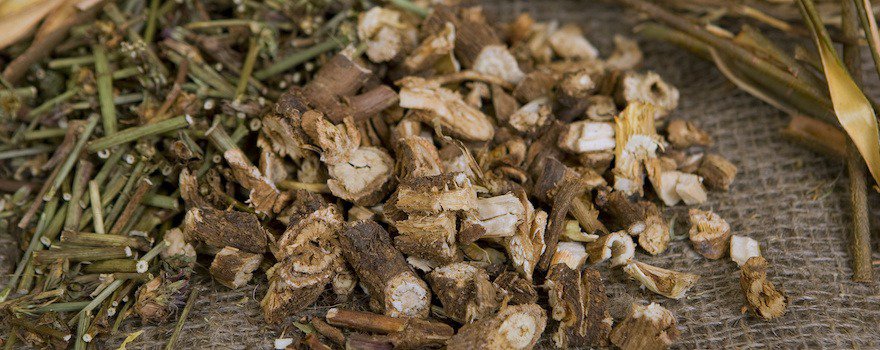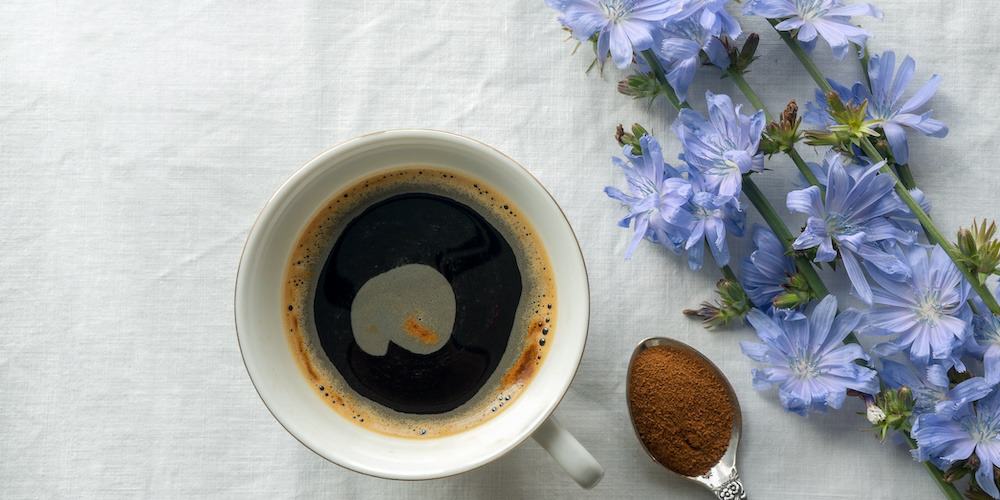BENEFITS OF CHICORY
✓ Improves gastrointestinal comfort
✓ Anti-inflammatory
✓ Antioxidant
✓ Improves diabetes
✓ Protects the heart
What is chicory?
Chicory is a plant of the Asteraceae family, like stevia or the yarrow. The genus Cichorium includes many wild or cultivated varieties, consumed either for their leaves or for their roots.
The Cichorium intybus or “wild chicory” is the best known of all. Its roots are harvested, roasted, and then ground into powder to obtain the famous hot beverage.
It grows naturally in Europe, India, and North Africa. Often considered a weed, it spreads quickly in meadows, wastelands, and along the edges of paths. The plant has a taproot, yellow-brown in color, and can reach up to 75 cm in length.
While chicory leaves are also edible, it is primarily its roots that are used in herbal medicine. In traditional medicine, they are used to relieve various ailments: wound treatment, diabetes, inflammation…
Since the 1980s, research has increased. It has revealed an exceptional composition and many benefits for the body. Thus, it improves gastrointestinal comfort and has antioxidant and anti-inflammatory effects. In addition, it helps alleviate diabetes and protects the heart.
Today, it is mainly cultivated for its roots, which are used to make a coffee substitute. But the inulin it contains is also used as a sweetening agent and as a texturizing agent in the food industry. Thanks to its sweet flavor, it could replace sweeteners and reduce the amount of sugars in processed foods.
Nutritional composition
- Acides aminés
- Vitamines : pro-vitamine A, B1, B2, B3, B9, E, K
- Minéraux et oligo-éléments : potassium, magnésium, sodium, fer, phosphore, calcium
- Protéines
- Fibres : inuline
- Sucres
- Glucides
- Acides naturels : chicorique, chlorogénique, linoléique, alpha-linoléique, stéarique, myristique, palmitique
- Actifs antioxydants : flavonoïdes, coumarines, polyphénols
- Tanins
- Substances amères : intybine, taraxarcine, lactucopricine, lactucine

Benefits of chicory
♻️ Improves gastrointestinal comfort
With about 3 g per 100 g, chicory is a noteworthy source of fiber. It contains soluble fibers, including inulin. Also found in artichoke and dandelion, this particular fiber improves gastrointestinal comfort.
Inulin exerts a prebiotic action — that is, it nourishes the beneficial bacteria of the microbiota. They can then fully play their role and grow under favorable conditions. Thus, it is among the best prebiotic foods, alongside carob or chia seeds. It is recommended for slow intestinal transit, difficult digestion, bloating, and constipation.
This study from Hokkaido Information University (Japan), conducted in humans, shows how chicory improves intestinal transit.
🔥 Anti-inflammatory
Thanks to its anti-inflammatory effects, chicory is useful for relieving the muscle and joint pain associated with osteoarthritis and arthritis. It also helps speed wound healing and relieve certain skin problems such as acne and eczema.
In addition, it contains intybin, a bitter substance with sedative and analgesic properties. It soothes and reduces the sensation of pain.
This study from the Southwest Medical Center of the University of Texas (United States), conducted on patients with osteoarthritis, shows the anti-inflammatory potential of chicory.
🥝 Antioxidant
Chicory root contains many antioxidant active compounds : flavonoids, coumarins, polyphenols… These compounds effectively fight free radicals and protect the body from their damage. They trap reactive free radicals, stimulate the immune system and boost the activity of antioxidant enzymes.
Its antioxidants also have hepatoprotective effects and reduce liver damage.
This study from Damanhour University (Egypt), conducted on rats, shows the antioxidant activity of chicory.
🍭 Improves diabetes
Regular consumption of chicory helps improve diabetes. In addition to reducing blood glucose levels, it lowers blood pressure, which is often very high in people with diabetes.
Its soluble fibers, including inulin, limit blood sugar spikes after meals, slow the absorption of carbohydrates, and improve insulin sensitivity.
This study from Tabriz University of Medical Sciences (Iran), conducted in diabetic patients, demonstrates chicory’s effectiveness in improving the condition.
❤️ Protects the heart
Chicory is a great protector of the heart and supports its proper functioning. The caffeic acid it contains inhibits platelet aggregation, which is responsible for thrombi (blood clots).
Moreover, by reducing systolic and diastolic blood pressure, this plant prevents many cardiovascular diseases. Finally, it reduces the viscosity of the blood and plasma for better circulation in the arteries.
This study from the University of Pécs (Hungary), conducted in humans, shows the cardioprotective effects of chicory.

How to consume chicory?
Soluble chicory
Harvested in the fall, chicory roots are then washed, cut, and dried. They are cut into ‘cossettes’ and undergo roasting that gives them a caramelized flavor. Finally, they are turned into granules and then atomized in a drying tower to obtain a fine powder.
Mixed with water or dairy or plant-based milk, the soluble form makes a delicious hot beverage that serves as a good substitute for coffee. It is prepared the same way and can be enjoyed at any time of day, even in the evening.

Dried chicory roots
Dried chicory roots can also be found. This form is useful for preparing a decoction to relieve gastrointestinal issues. To do this, simply boil 50 g of roots in 50 cl of water and let steep for about 10 minutes. Strain, then enjoy.
Consume sustainably: prioritize local, organic, and fair-trade chicory
✓ Chicory is cultivated in many countries around the world (South Africa, United States, Australia, India…) and in Europe (Belgium, the Netherlands, Germany…). France is simply the leading European producer. With 50 000 tonnes harvested each year, the Nord-Pas-de-Calais accounts for 95% of French production !
✓ Chicory grown in France is therefore easy to find. Choose chicory from organic farming and/or fair trade supply chains.
Dosage
The recommended dosage is 3 to 5 g of chicory per day.
Contraindications and side effects
There are some contraindications to consuming chicory:
- Par mesure de précaution, on la déconseille aux femmes enceintes et allaitantes et aux jeunes enfants ;
- Sa consommation est déconseillée en cas de calculs biliaires ;
- Les personnes allergiques aux plantes de la famille des Astéracées doivent éviter d’en consommer ;
- Parce qu’elle est riche en vitamine K, elle est déconseillée en cas de traitement anticoagulant.
Consumption of chicory may have certain side effects:
- Douleurs gastriques
- Flatulences
- Diarrhées
- Réaction allergique
If you experience side effects, stop using it and consult a doctor.
Report compiled by Julia Perez
Sources and scientific studies
Renée A Street, Jasmeen Sidana, Gerhard Prinsloo, 2013. Cichorium intybus : Traditional Uses, Phytochemistry, Pharmacology, and Toxicology.
Mie Nishimura, Tatsuya Ohkawara, Toshiyuki Kanayama, Kazuya Kitagawa , Hiroyuki Nishimura, Jun Nishihira, 2015. Effects of the extract from roasted chicory (Cichorium intybus L.) root containing inulin-type fructans on blood glucose, lipid metabolism, and fecal properties.
Nancy J Olsen, Valerie K Branch, Geetha Jonnala, Mira Seskar, Melisa Cooper, 2010. Phase 1, placebo-controlled, dose escalation trial of chicory root extract in patients with osteoarthritis of the hip or knee.
Yasser El-Sayed, Mohamed Lebda, Mohammed Hassinin, Saad A Neoman, 2015. Chicory (Cichorium intybus L.) Root Extract Regulates the Oxidative Status and Antioxidant Gene Transcripts in CCl4-Induced Hepatotoxicity.
Mahdieh Abbasalizad Farhangi, Ahmad Zare Javid, Parvin Dehghan, 2015. The effect of enriched chicory inulin on liver enzymes, calcium homeostasis and hematological parameters in patients with type 2 diabetes mellitus: A randomized placebo-controlled trial.
Edit Schumacher, Eva Vigh, Valéria Molnár, Peter Kenyeres, 2011. Thrombosis Preventive Potential of Chicory Coffee Consumption: A Clinical Study.



